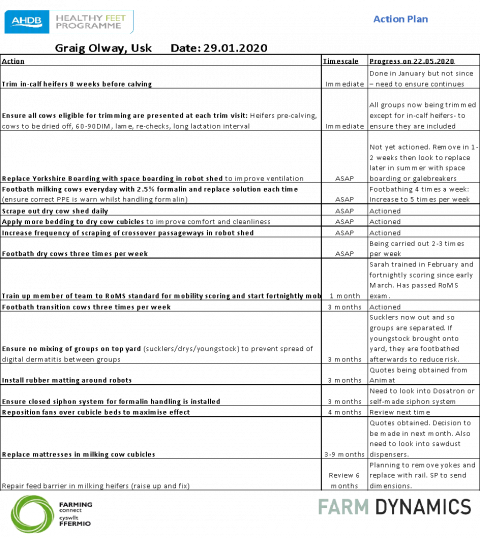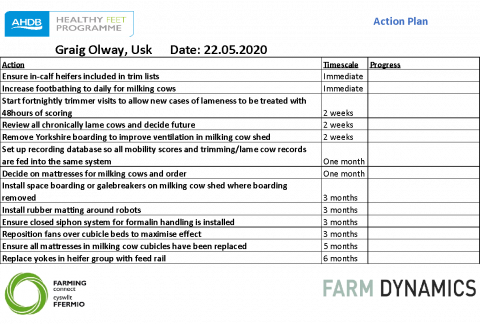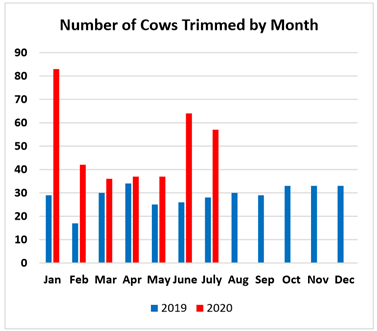Focus on Feet update at Graig Olway
Mobility has a significant impact on welfare and productivity of a dairy cow and is a crucial welfare issue which can lead to a financial cost of £180 on average per incidence. Depending on the severity and problem, lameness effects a cow’s performance due to the decrease in yield, fertility and longevity. In January 2020, the team working at Graig Olway sat down with Sara Pedersen and the farm’s vet to discuss what was going well and areas to improve on and put an action plan in place (Figure 1). When the whole herd was mobility scored in January, lameness was at 39%.
Figure 1. 29.01.2020 Action plan, and progression at Graig Olway.
Small changes to management were the main actions implemented immediately such as ensuring comfort and cleanliness of the dry cows were not forgotten. Dry cows are now foot bathed three times a week for preventative measures and housing has been scraped out daily to reduce slurry build-up and the spread of infection. Also, more bedding is spread on the cubicles to improve comfort and cleanliness which will reduce standing time and pressure on the feet. Much of the action plan has been completed including major investments such as the recent replacement of the mattresses in the cow sheds in August. Heat stress has been a challenge this summer and whilst removing the Yorkshire boarding has improved air flow, mechanical ventilation will need to be researched for next year. Cows are now grazing for a few hours a day to assist in reducing the impacts of heat stress.
Sara advised to increase foot bathing frequency of the milking herd to 4-5 times per week and replacing the solution each time to guarantee the correct percentage of solution and clean water. Although this may be difficult in a robotic system with the cows not walking out of the parlour daily, Russell has a great set up in place which makes the procedure hassle and stress free with footbaths installed at the cross-overs at the end of the housing. Another key aspect for the management of mobility and lameness is ensuring all lame and routine cows are seen by the foot trimmer, therefore, Russell’s partner has completed the RoMS course and has been mobility scoring the herd fortnightly since March. This ensures that any new cases of lameness are detected early and examined by the farm team or at the next routine foot trimming visit. It also helps monitor the progress of treated cases.
In May, the whole team met again virtually to review the action plan (Figure 2) and decided on the next steps.
Figure 2. Action plan implemented during team meeting reviewing the project work in May.
The team agreed to increase foot trimming visits to fortnightly to coincide with mobility scoring which will allow lame cows to be seen earlier, especially new cases. Increasing foot trimming visits will also give the foot trimmer time for routine trims, especially the in-calf heifers. If a heifer is lame during her first lactation, she is three times more likely to become lame in her second lactation and therefore, lameness control for heifers can progressively reduce whole herd lameness and improve cow longevity. More regular trimming visits also allows for cows to be seen at the correct time for their early lactation trim between 70-80 days in milk. The trimming protocols put in place as part of the action plan are being followed and as a result a larger number of trims has been undertaken this year in comparison to last year (Graph 1). Whilst detection of early cases of lameness is excellent, the response to treatment has been falling below target levels and this is being monitored to identify the reasons for this.
Graph 1. Comparison of the number of Cows trimmed by month in 2019 and 2020
Whilst digital dermatitis levels were initially controlled following the blitz treatment in January (using licensed topical antibiotics treatment, re-examined for two consecutive days and repeat treatments given where necessary), there have been a few flare ups since and are mostly driven by repeat offenders. Footbathing regimes are being reviewed and culling decisions made on the chronic carriers. Analysis of the foot trimming records has identified that 40% of the lesions recorded this year have been repeat cases demonstrating the legacy of historic cases of lameness in driving current patterns. The future aim is to continue to manage these previous cases whilst ensuring new cases are reduced.
The next steps will include identifying the reason for the below target levels of response to treatment. With many of the major changes already being put in place, the key is now to continue to monitor lameness and identify where further improvements can be made, especially in terms of cow comfort and digital dermatitis control.



